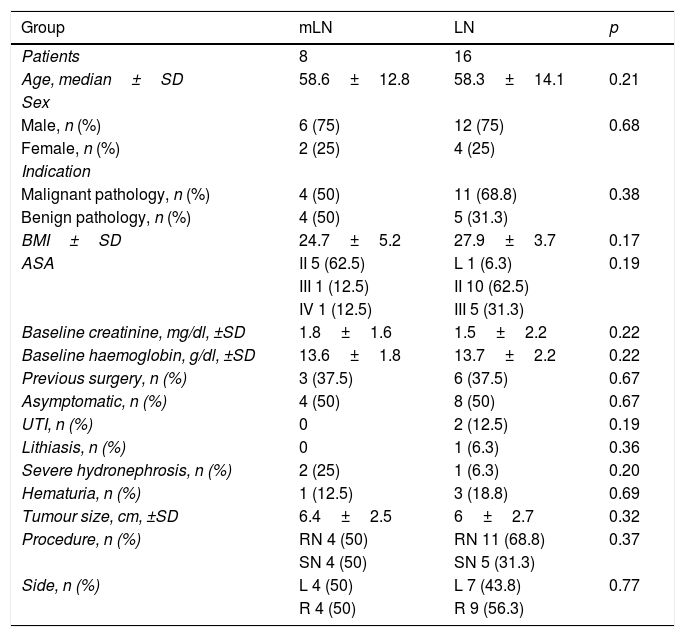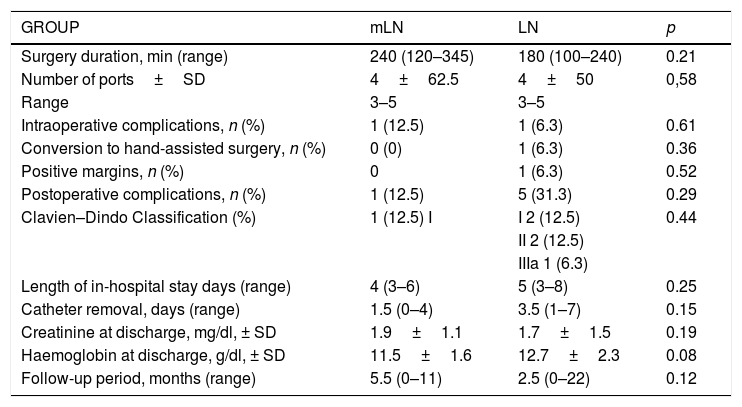In recent years urology has been focussing on less invasive forms of laparoscopy with less impact on the abdominal wall. The minilaparoscopy (ML) is promising in this regard. Our objective is to compare the results of a series of patients who underwent minilaparoscopic nephrectomy with another series who underwent conventional laparoscopy (CL).
Material and methodsWe chose 8 nephrectomies performed by mini-laparoscopy in a single hospital (NmL group) from a total of 110 patients included in multiple centres and compared them retrospectively with a contemporary series of 16 patients who underwent CL (NL group). From 1 to 3 3mm and 5mm trocars were used for the NmL and the NL, respectively, one 10mm trocar in the pararectal edge of a Pfannenstiel incision and another 11mm paraumbilical trocar for the optics. Age, BMI, ASA, complications, analgesic requirements in the postoperative period and cosmetic satisfaction were recorded using the Patient Scar Assessment Questionnaire (PSAQ), one month after the intervention.
ResultsBoth groups were comparable and there were no differences in terms of surgery time, number of ports used, hospital stay or intra-and postoperative complications. In only one patient from the NmL group, a 3mm trocar had to be replaced by a 5mm trocar and one patient in the NL group was converted to hand-assisted surgery due to severe adherences. The patients in the NmL group had less postoperative pain on the VAS (±0 vs. 4±25, p=0.05) and were more satisfied with their appearance on the PSAQ (8.5±1.4 vs. 16.6±3.1, p=0.05) compared to the NL group.
ConclusionsThe results obtained with the ML instrument were similar to those obtained by CL, but with the advantages of less postoperative pain and better cosmetic results.
En los últimos años la urología se ha orientado a formas menos invasivas de laparoscopia con un menor impacto en la pared abdominal. Entre ellas ha surgido de una forma prometedora la minilaparoscopia (ML). Nuestro objetivo es comparar los resultados de una serie de pacientes intervenidos de nefrectomía minilaparoscópica y otra mediante laparoscopia convencional (LC).
Material y métodosSeleccionamos en un único hospital 8 nefrectomías realizadas por minilaparoscopia (grupo NmL) de un total de 110 pacientes incluidos en múltiples centros y las comparamos retrospectivamente con una serie contemporánea de 16 pacientes intervenidos por LC (grupo NL). Se emplearon de 1 a 3 trocares de 3mm y de 5mm para la NmL y NL, respectivamente, un trocar de 10mm en el borde pararrectal de una incisión de Pfannenstiel y otro de 11mm paraumbilical para la óptica. Se recogieron la edad, el IMC, el ASA, las complicaciones, los requerimientos analgésicos en el postoperatorio y la satisfacción cosmética mediante el Patient Scar Assessment Questionnaire (PSAQ) al mes de la intervención.
ResultadosAmbos grupos fueron comparables y no presentaron diferencias en cuanto al tiempo quirúrgico, número de puertos empleados, estancia hospitalaria y complicaciones intra y postoperatorias. Solo en un paciente del grupo NmL un trocar de 3mm requirió ser substituido por otro de 5mm y un paciente del grupo NL fue convertido a cirugía mano-asistida por intensas adherencias. Los pacientes del grupo NmL presentaron menos dolor postoperatorio en la escala EVA (± 0 vs. 4±25, p=0,05) y mejor satisfacción en la apariencia en el PSAQ (8,5±1,4 vs. 16,6±3,1, p=0,05) respecto al grupo NL.
ConclusionesLos resultados obtenidos con el instrumental de ML fueron semejantes a los obtenidos por LC, pero con las ventajas de un menor dolor postoperatorio y mejores resultados cosméticos.
Artículo
Comprando el artículo el PDF del mismo podrá ser descargado
Precio 19,34 €
Comprar ahora













